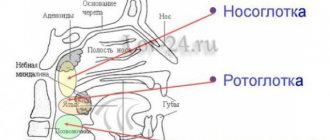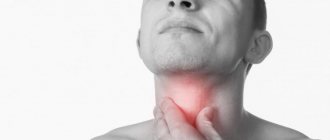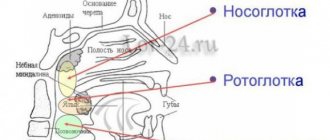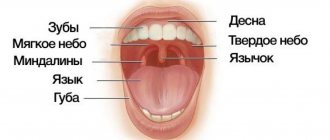CLINICAL ANATOMY OF THE LARYNX.
CLINICAL ANATOMY OF THE LARYNX
The larynx
(Larynx)
is a hollow organ whose upper part opens into the laryngopharynx and the lower part passes into the trachea. The larynx is located under the hyoid bone on the front surface of the neck. The inside of the larynx is lined with a mucous membrane and consists of a cartilaginous skeleton connected by ligaments, joints and muscles. The upper edge of the larynx is located on the border of the IV and V cervical vertebrae, and the lower edge corresponds to the VI cervical vertebra. The outside of the larynx is covered with muscles, subcutaneous tissue and skin, which is easily displaced, allowing it to be palpated. The larynx makes active movements up and down when speaking, singing, breathing and swallowing. In addition to active movements, it passively shifts to the right and left, and the so-called crepitus of the laryngeal cartilages is noted. In the case of a malignant tumor, the active mobility of the larynx decreases, as well as its passive displacement.
In men, in the upper part of the thyroid cartilage, a protrusion or elevation is clearly visible and palpable - the Adam's apple, or Adam's apple (prominentia laryngea, s. pomum Adami).
In women and children it is less pronounced, soft and its palpation determination is difficult.
In the lower part of the larynx in front, between the thyroid and cricoid cartilages, you can easily feel the area of the conical ligament (lig. Conicum, s. cricothyreoideum),
which is dissected (conicotomy) if it is necessary to urgently restore breathing in case of asphyxia.
Laryngeal cartilages.
The skeleton of the larynx is made up of cartilages
(cartilagines laryngis),
connected by ligaments (Fig. 4.1 a, b). There are three single and three paired cartilages of the larynx:
• Three singles:
1) cricoid cartilage (cartilago cricoidea)
;
2) thyroid cartilage (cartilago thyreoidea)
;
3) epiglottic cartilage (cartilago epiglotica)
or epiglottis
(epiglottis).
Rice. 4.1.
Skeleton of the larynx:
a – front view; b – rear view: 1 – thyroid cartilage; 2 - cricoid cartilage; 3 – epiglottis; 4 – arytenoid cartilage; 5 – tracheal rings; b – hyoid bone
• Three doubles:
1) arytenoid cartilages (cartilagines arytaenoidea);
2) corniculate cartilages (cartilagines corniculatae);
3) wedge-shaped cartilages (cartilagines cuneiformes, s. Wrisbergi).
Cricoid cartilage (cartilago cricoidea)
is the basis of the skeleton of the larynx.
In shape it really resembles a signet ring facing backwards. The narrow part facing forward is called the arc (arcus),
and the widened rear part is called the signet or plate
(lamina).
The lateral surfaces of the cricoid cartilage have superior and inferior articular platforms for articulation with the arytenoid and thyroid cartilages, respectively.
Thyroid cartilage (cartilago thyreoidea),
the largest cartilage of the larynx, located above the cricoid cartilage (Fig. 4.2). Thyroid cartilage confirms its name both by its appearance and its role in protecting the internal part of the organ. Two irregularly shaped quadrangular plates that make up the cartilage at the site of fusion
Rice. 4.2.
Thyroid cartilage
in front along the midline they form a ridge, at the upper edge of which there is a notch (tasura thyreoidea).
On the inner surface of the angle formed by the plates of the thyroid cartilage, there is an elevation to which the vocal folds are attached. At both sides
the posterior sections of the plates of the thyroid cartilage have processes extending upward and downward - the upper and lower horns (cornila). The lower ones - shorter ones - serve for articulation with the cricoid cartilage, and the upper ones are directed towards the hyoid bone, where they are connected to its large horns by the thyrohyoid membrane. On the outer surface of the plates of the thyroid cartilage there is an oblique line (linea oblique),
running from back to front and from top to bottom, to which part of the external muscles of the larynx is attached.
Epiglottic cartilage (cartilago epiglottica),
or epiglottis, is a leaf-shaped plate resembling a flower petal.
Its wide part stands freely above the thyroid cartilage, is located behind the root of the tongue and is called the petal. The narrow lower part - the stalk (petiolus epiglottis)
- is attached to the inner surface of the angle of the thyroid cartilage by means of a ligament. The shape of the lobe of the epiglottis varies depending on how much it is thrown back, elongated or curled, which is sometimes associated with errors during tracheal intubation.
Arytenoid cartilages (cartilagines arythenoideae)
have the shape of triangular pyramids, the tops of which are directed upward, somewhat posteriorly and medially.
The base of the pyramid articulates with the articular surface of the signet of the cricoid cartilage. to the anterior internal corner of the base of the arytenoid cartilage - the vocal process (processus vocalis)
, and the
- to the anterior external angle (processus muscularis)
. The second part of the vocal muscle is fixed to the lateral surface of the pyramid of the arytenoid cartilage in the region of its anteroinferior third, where the oblong fossa is located.
Wedge-shaped cartilages (cartilagines cuneiformes, s. Wrisbergi)
located in the thickness of the aryepiglottic fold.
Horn-shaped cartilages (cartilagines corniculatae)
located above the apex of the arytenoid cartilages. Wedge-shaped and corniculate cartilages are small-sized sesamoid cartilages, not constant in shape and size.
Joints of the larynx.
The larynx has two paired joints.
1. Cricothyroid joint (articulatio cricothyreoidea)
formed by the lateral surface of the cricoid cartilage and the lower horn of the thyroid cartilage. By bending forward or backward at this joint, the thyroid cartilage thereby increases or decreases the tension of the vocal folds, changing the pitch of the voice.
2. Cricoarytenoid joint (articulatio cricoarytenoidea)
formed by the lower surface of the arytenoid cartilage and the upper articular platform of the cricoid cartilage plate. Movements in the cricoarytenoid joint (forward, backward, medial and lateral) determine the width of the glottis.
Laryngeal ligaments
(Fig. 4.3). The main ligaments of the larynx include:
Rice. 4.3.
Laryngeal ligaments:
a – front view; b – posterior view: 1 – lateral thyrohyoid, 2 – cricotracheal, 3 – cricothyroid, 4 – aryepiglottic fold
• thyrohyoid medial and lateral (tig. hyothyreoideum medium et lateralis);
• thyroid epiglottis (tig. thyreoepigtotticum);
• sublingual-epiglottic (tig. hyoepigtotticum);
• cricotracheal (tig. cricotracheate);
• cricothyroid (tig. cricothyroideum);
• vocal fold (ptica vocate);
• aryepiglottic (tig. aryepigtotticum);
• lingual-epiglottic middle and lateral (tig. gtossoepigtotticum medium et tateratis).
Thyrohyoid median and lateral ligaments
are parts of the thyrohyoid membrane
(membrana thyrohyoidea),
with the help of which the larynx is suspended from the hyoid bone. The median thyrohyoid ligament connects the upper edge of the thyroid cartilage with the body of the hyoid bone, and the lateral ligament connects with the greater horns of the hyoid bone. The neurovascular bundle of the larynx passes through the hole in the outer part of the thyrohyoid membrane.
Thyroglottic ligament
connects the epiglottis with the thyroid cartilage in the area of its upper edge.
Hypoepiglottic ligament
connects the epiglottis to the body of the hyoid bone.
Cricotracheal ligament
connects the larynx with the trachea; located between the cricoid cartilage and the first ring of the larynx.
Cricoid or conical ligament
connects the upper edge of the cricoid cartilage arch and the lower edge of the thyroid cartilage.
The cricothyroid ligament is a continuation of the elastic membrane of the larynx (conus etasticus),
which begins on the inner surface of the plates of the thyroid cartilage in the region of its angle. From here, the elastic bundles fan out vertically downwards towards the upper edge of the arch of the cricoid cartilage in the form of a cone, forming a conical ligament. The elastic membrane forms a layer between the inner surface of the cartilage and the mucous membrane of the larynx.
Vocal fold
is the superior posterior bundle of the elastic cone;
covers the vocal muscle, which is stretched between the inner surface of the angle of the thyroid cartilage in front and the vocal process (processus vocatis)
of the arytenoid cartilage in the back.
aryepiglottic ligament
located between the lateral edge of the epiglottis and the inner edge of the arytenoid cartilage.
Glossoepiglottic median and lateral ligaments
They connect the middle and lateral parts of the root of the tongue with the anterior surface of the epiglottis; between them there are depressions - the right and left fossae of the epiglottis (valecula).
Muscles of the larynx
(Fig. 4.4). All muscles of the larynx can be divided into two large groups:
1) external muscles involved in the movement of the entire larynx as a whole;
2) internal muscles that cause the movement of the cartilages of the larynx relative to each other; these muscles are involved in the functions of breathing, sound production and swallowing.
External muscles
Depending on the place of attachment, they can be divided into two more groups:
Rice. 4.4.
Muscles of the larynx:
a – external muscles: 1 – sternohyoid, 2 – geniohyoid, 3 – stylohyoid, 4 – digastric, 5 – sternothyroid, 6 – thyrohyoid, 7 – sternocleidomastoid, 8 – cricothyroid, 9 – omohyoid ; b – internal muscles: 1 – oblique arytenoid muscle, 2 – aryepiglottic, 3 – transverse arytenoid, 4 – posterior cricoarytenoid, 5 – cricothyroid
1. To the first group
There are two paired muscles, one end of which is attached to the thyroid cartilage, and the other to the bones of the skeleton:
• sternothyroid (m. sternothyroideus);
• thyrohyoid (m. thyrohyodeus).
2. Muscles of the second group
attached to the hyoid bone and to the bones of the skeleton:
• sternohyoid (m. sternohyoideus);
• scapular-hyoid (m. omohyoideus);
• stylohyoid (m. stylohyoideus)
;
• digastric (m. digastricus)
;
• geniohyoid (m. geniohyoideus). Internal muscles
the larynx performs two main functions in the larynx
Features:
1. Change the position of the epiglottis during the act of swallowing and inhalation, performing a valve function.
2. Change the tension of the vocal folds and the width of the glottis between them (voice function).
The position of the epiglottis is changed by two pairs of antagonist muscles.
Arepiglottic muscle (m. aryepiglotticus)
located between the apex of the arytenoid cartilage and the lateral edges of the epiglottis. Being covered with mucous membrane, this muscle forms the aryepiglottic fold in the area of the lateral entrance to the larynx. During the act of swallowing, contraction of the aryepiglottic muscle leads to the retraction of the epiglottis backward and downward, due to which the entrance to the larynx is covered and food is displaced laterally into the pyriform fossa towards the entrance to the esophagus.
Thyroepiglotticus muscle (m. thyroepiglotticus)
stretched on the sides of the thyroid epiglottis between the inner surface of the angle of the thyroid cartilage and the lateral edge of the epiglottis. When the thyroepiglottic muscle contracts, the epiglottis rises and the entrance to the larynx opens.
The muscle group that performs the function of the vocal apparatus is more numerous than the previous one and is divided into muscle groups that constrict, dilate, tense and relax.
glottis.
Lateral cricoarytenoid muscle (m. cricoarytenoideus lateralis)
(paired) begins on the lateral surface of the cricoid
th cartilage and is attached to the muscular process of the arytenoid cartilage. When it contracts, the muscle processes move forward and down, and the vocal processes move closer together, narrowing the glottis.
Transverse arytenoid muscle (m. arytenoideus transverses)
connects the posterior surfaces of the arytenoid cartilages with each other, which, when it contracts, come closer together, narrowing the glottis mainly in the posterior third.
Oblique arytenoid muscle (m. arytenoideus obliqus)
(paired) begins on the posterior surface of the muscular process of one arytenoid cartilage and is attached to the apex of the arytenoid cartilage of the opposite side. Both oblique arytenoid muscles enhance the function of the transverse arytenoid muscle, located directly behind it, crossing each other at an acute angle.
Posterior cricoarytenoid muscle (m. cricoarytenoideus post. s. posticus)
begins on the posterior surface of the cricoid cartilage and attaches to the muscular process of the arytenoid cartilage. When inhaling, it contracts, the muscular processes of the arytenoid cartilages rotate posteriorly, and the vocal processes, together with the vocal folds, move to the sides, expanding the lumen of the larynx. This is the only muscle that opens the glottis. When it is paralyzed, the lumen of the larynx closes and breathing becomes impossible.
Thyroarytenoid muscle (m. thyreoarytaenoides)
begins on the inner surface of the plates of the thyroid cartilage. Going posteriorly and upward, it attaches to the lateral edge of the arytenoid cartilage. During contraction, the arytenoid cartilage rotates outward around its longitudinal axis and moves anteriorly.
Cricothyroid muscle (m. cricothyroideus)
It is attached at one end to the anterior surface of the cricoid cartilage arch on the side of the midline, and at the other to the lower edge of the thyroid cartilage. When this muscle contracts, the thyroid cartilage bends forward, the vocal folds become tense, and the glottis narrows.
Vocal muscle (m. vocalis)
- triceps, makes up the bulk of the vocal fold; begins in the region of the lower third of the angle formed by the inner surfaces of the plates of the thyroid cartilage, and is attached to the vocal process of the arytenoid cartilage.
A narrow strip of elastic connective tissue runs along the medial edge of the muscle; it plays a significant role in the formation of sound. When this muscle contracts, the vocal folds thicken and shorten, the elasticity, shape and tension of its individual sections change, which plays an important role in voice formation.
TOPOGRAPHY OF THE LARYNX
Larynx
suspended from the hyoid bone by the thyrohyoid membrane;
downwards it passes into the trachea, attached to it by the cricotracheal ligament. In front, the larynx is covered with skin, subcutaneous tissue, superficial fascia of the neck, and muscles. The fascia of the thyroid gland is attached to the lower part of the cricoid cartilage in front, the lateral parts of which cover the muscles (m. sternothyroideus et m. sternohyoideus).
The anterolateral surface of the larynx is covered by the sternohyoid muscle, and under it are the sternothyroid and thyrohyoid muscles. At the back, the larynx borders the laryngeal part of the pharynx and the entrance to the esophagus. On the sides of the larynx lie neurovascular bundles.
Blood supply to the larynx
carried out by two arteries:
• superior laryngeal (a. laryngea superior);
• lower laryngeal (a. laryngea inferior).
Superior laryngeal artery
is a branch of the superior thyroid artery
(a. thyreoidea superior),
which, in turn, arises from the external carotid artery.
The superior laryngeal artery is larger than the inferior one. As part of the neurovascular bundle of the larynx (a. laryngea superior, v. laryngea superior, ramus internus n. laryngei superior),
the artery penetrates the larynx through an opening in the outer part of the thyrohyoid membrane.
Inside the larynx, the superior laryngeal artery is divided into smaller branches, where another branch departs from it - the middle laryngeal artery (a. laryngea media),
which anastomoses with the artery of the same name on the opposite side in front of the conical ligament.
Inferior laryngeal artery
is a branch of the inferior thyroid artery
(a. thyreoidea inferior),
which originates from the thyroid trunk
(truncus thyreocervicalis).
Venous drainage
is provided cranially through the superior thyroid vein
(v. laryngea superior)
into the internal jugular vein
(v. jugularis interna),
caudally through the inferior thyroid vein
(v. laryngea inferior)
into the brachiocephalic vein
(v. brachiocephalica).
Lymphatic system
The larynx is divided into:
• upper section;
• lower section, which are separated by vocal folds. The lymphatic network of the upper section is more developed ,
especially in
areas of the vestibular folds and laryngeal ventricles. From here, the lymph, converging with other lymphatic vessels, is directed along the neurovascular bundle of the larynx to the deep cervical lymph nodes located along the deep jugular vein.
Lymphatic vessels of the lower section
pass under and above the cricoid cartilage, collecting in the preepiglottic lymph nodes. In addition, there is a connection with the deep cervical lymph nodes located along the deep jugular vein. Contralateral metastasis is possible here due to the existence of a connection with the pre- and paratracheal lymph nodes. The connection between the lymphatic system of the lower larynx and the mediastinal lymph nodes is of great clinical importance.
Innervation of the muscles of the larynx
provided by two branches of the vagus nerve:
• superior laryngeal nerve (n. laryngeus superior);
• lower laryngeal nerve (n. laryngeus inferior sn recurrens).
Superior laryngeal nerve
is mixed and departs from the vagus nerve in the region of the lower part of the vagus nerve ganglion
(ganglion nodosum n. vagi).
Behind the greater horn of the hyoid bone, the superior laryngeal nerve is divided into two branches: the external branch
(r. externus),
motor, innervating the cricothyroid muscle, and the internal branch
(r. internus),
penetrating through the hole in the thyrohyoid membrane; it gives off sensitive branches to the mucous membrane of the larynx.
Inferior laryngeal nerve (n. recurens)
mixed, innervates all the internal muscles of the larynx with the exception of the cricothyroid muscle and provides sensitive innervation to the mucous membrane of the lower floor of the larynx, including the area of the vocal folds. The lower laryngeal nerves on different sides are continuations of the right and left recurrent nerves, which arise from the vagus nerve in the chest cavity at different levels. The right recurrent nerve departs from the vagus nerve at the level of the subclavian artery, the left - at the place where the vagus nerve bends around the aortic arch. Next, the recurrent nerves of both sides rise up to the larynx,
giving numerous branches to the trachea and esophagus on its way, with the right one located laterally between the trachea and esophagus, and the left one lying on the anterior surface of the esophagus on the left.
The sympathetic nerves arise from the superior cervical sympathetic cervicothoracic (stellate) ganglion (ganglion stellatum).
The cavity of the larynx
(cavitas laryngis),
shaped like an hourglass, is narrowed in the middle section and expanded upward and downward. According to clinical and anatomical characteristics, it is divided into three floors (Fig. 4.5):
• upper
- vestibule of the larynx
(vestibulum laryngis)
- located between the entrance to the larynx and the vestibular folds, has the appearance of a cone-shaped cavity, tapering downwards;
• average
- glottis
(rima vocalis)
- the space between the vocal folds through which communication occurs with the lower floor of the larynx;
• lower
- subglottic cavity, extending from the vocal folds to the trachea, having the appearance of a cone-shaped cavity, expanding downwards.
Entrance to the larynx
in front is limited by the epiglottis, behind - by the apices of the arytenoid cartilages and on the sides - by the aryepiglottis.
mi folds, in the lower part of which lie corniculate and wedge-shaped cartilages, forming tubercles of the same name. Between the aryepiglottic folds and the walls of the pharynx there are pear-shaped pockets (recessus piriformes),
which behind the larynx pass into the esophagus. At the bottom of the pyriform sinus there is a fold of mucous membrane running posteriorly and downward, formed by the internal branch of the superior laryngeal nerve and the superior laryngeal
Rice. 4.5.
Floors of the larynx: 1 – upper; 2 – average; 3 – lower
artery. The recesses between the median and lateral lingual epiglottic folds, which connect the anterior surface of the epiglottis with the root of the tongue, are called lingual epiglottic recesses.
or
valleculae (valleculae epiglotticae).
At the level of the middle and lower third of the thyroid cartilage in the laryngeal cavity, on either side of the midline there are two pairs of horizontal folds of the mucous membrane.
The upper pair are called vestibule folds (plica vestibularis),
the lower ones are called
vocal folds (plica vocalis).
The length of the vocal folds in newborns is 0.7 cm;
in women - 1.6-2 cm; in men - 2-2.4 cm. On each side between the vocal and vestibular folds there are depressions - laryngeal
(Morgani)
ventricles (ventriculi laryngis),
in which there is a pocket outward and anteriorly, ascending upward. In the thickness of the mucous membrane of the laryngeal ventricles there is an accumulation of lymphadenoid tissue, which is sometimes called laryngeal tonsils, and when they are inflamed, accordingly, laryngeal tonsillitis. The width of the lumen (the glottis between the vocal folds in the posterior third) of the larynx in men is about 15-22 mm, in women – 13-18 mm, in a 10-year-old child – 8-11 mm.
The mucous membrane of the larynx is a continuation of the mucous membrane of the nasal cavity and pharynx and is covered mainly by multirow cylindrical ciliated epithelium. The vocal folds, the upper part of the epiglottis, the arytenoid folds and the laryngeal surface of the arytenoid cartilages are lined with stratified squamous epithelium, which is important to consider in the diagnosis of tumor diseases.
4.2. CLINICAL ANATOMY OF TRACHEA AND ESOPHAGUS
The trachea
(tracheae)
is a hollow cylindrical tube that is a direct continuation of the larynx (Fig. 4.6). The trachea begins at the level of the body of the VII cervical vertebra and extends to the level of the bodies of the IV-V thoracic vertebrae, where it ends in a branching (bifurcation) into two main bronchi. The level of bifurcation is higher in young people. The length of the trachea is on average 10-13 cm. The wall of the trachea consists of 16-20 hyaline cartilages, shaped like a horseshoe, the arc of which faces forward, and the rear open ends are connected by a connective tissue membrane - the membranous part of the wall.
Rice. 4.6.
Trachea skeleton
ki of the trachea (paries membranaceus tracheae).
This membrane contains elastic and collagen fibers, and in deeper layers - longitudinal and transverse smooth muscle fibers.
The width of the membranous wall ranges from 10 to 22 mm. The hyaline cartilages of the trachea (cartilagines trachealis)
are connected to each other by means of annular ligaments
(lig. annularia).
The inner surface of the trachea is lined with mucous membrane,
covered with columnar ciliated epithelium. In the submucosal layer there are mixed glands that produce a protein-mucosal secretion. On the inside of the trachea, at the site of its division into two main bronchi, a semilunar-shaped protrusion is formed - the junction of the medial walls of the main bronchi - the tracheal spur (carina trachea).
The right bronchus is wider, extends from the trachea at an angle of 15°, its length is 3 cm; the left one is at an angle of 45°, its length is 5 cm. Thus, the right bronchus is practically a continuation of the trachea, and therefore foreign bodies more often enter it.
TOPOGRAPHY OF THE TRACHEA
From above, the trachea is attached to the cricoid cartilage by the cricotracheal ligament (lig. cricotrachaele).
In the cervical part, the isthmus of the thyroid gland is adjacent to the anterior surface of the trachea, and its lobes are adjacent to the sides. Posteriorly, the trachea is adjacent to the esophagus. To the right of the trachea is the brachiocephalic trunk, to the left is the left common carotid artery (Fig. 4.7).
In the thoracic region in front of the trachea is the aortic arch. To the right of the trachea are the right pleural sac and the right vagus nerve, to the left are the aortic arch, left carotid and subclavian nerves.
Rice. 4.7.
Topography of the trachea: 1 – thyroid gland; 2 – common carotid artery; 3 – aortic arch; 4 – thymus gland; 5 – vagus nerve
arteries, left recurrent nerve. In children under 16 years of age, the thymus gland is located in the thoracic region in front of the trachea.
Blood supply to the trachea
carried out using the inferior thyroid
(a. thyroidea inferior)
and internal thoracic arteries
(a. thoracica interna),
as well as
counting the bronchial branches of the thoracic aorta (rami bronchiales aortae thoracicae).
In the innervation of the trachea
(n. vagus)
and the tracheal branches of the lower laryngeal nerve
(n. laryngeus inferior)
take part The sympathetic influence is represented by nerves arising from the sympathetic trunk
(truncus sympathicus).
Lymph
The trachea flows mainly into the lymph nodes located on both sides on its sides. In addition, the lymphatic system of the trachea has connections with the lymph nodes of the larynx, upper deep cervical and anterior mediastinal nodes.
Esophagus
is a hollow organ in the form of a tube that connects the pharyngeal cavity with the stomach cavity. From above, the pharynx passes into the esophagus in the projection area of the VI cervical vertebra at the level of the lower edge of the cricoid cartilage. Below, the junction of the esophagus with the stomach corresponds to the level of the XI thoracic vertebra. The length of the esophagus in an adult is on average 23-25 cm, and the width is from 15 to 20 mm.
There are three sections in the esophagus:
• cervical;
• chest;
• abdominal.
Cervical region
extends from the level of the VI cervical vertebra to the thoracic vertebra, its length ranges from 5 to 8 cm. The anterior border with the thoracic region is the level of the jugular notch.
Thoracic region
has the greatest length - 15-18 cm and ends at the level of the X-XI thoracic vertebrae at the point of entry into the diaphragm through the esophageal opening
(hiatus esophageus).
The abdominal section is 1-3 cm in length and ends in a slight expansion at the junction with the stomach.
Extending in front of the spine, the esophagus along its path has four bends (two in the sagittal and two in the frontal planes) and three narrowings. First narrowing
located at the junction of the pharynx and the esophagus (15 cm from the upper edge of the incisors).
The pressure of the aorta and the left main bronchus determines the existence of a second narrowing
of the esophagus.
The third narrowing
is at the point of passage through
the hiatus esophageus
(Fig. 4.8).
In the cervical region, on the sides, the common carotid arteries and recurrent laryngeal nerves are close to the esophagus. In the thoracic region, at the level of the IV-V thoracic vertebrae, the esophagus passes next to the aortic arch. In the lower third, the esophagus touches the pericardium and passes into the abdominal part, which is covered in front by the left lobe of the liver.
The wall of the esophagus has three layers: internal (mucous), middle (muscular) and external (connective tissue).
Innervation
The esophagus is carried out by the esophageal plexus
(plexus esophagealis).
Blood supply
the esophagus in the cervical region is carried out by the lower thyroid gland
Rice. 4.8.
Physiological narrowing of the esophagus
no artery (a. thyroidea inferior),
in the thoracic region - by the esophageal and bronchial arteries
(aa. esophageae, bronchiales),
in the abdominal region - by the left gastric artery
(a. gastrica sinistra),
the lower left renal artery
(a. phrenica inferior sinistra).
4.3. CLINICAL PHYSIOLOGY OF THE LARRYNX, TRACHEA AND ESOPHAGUS
The larynx and trachea perform respiratory, protective and voice-forming functions.
Respiratory function
- The larynx conducts air to the lower sections - the trachea, bronchi and lungs. When inhaling, the glottis expands, and the size of the glottis varies depending on the needs of the body. With a deep breath, the glottis expands more, so that even the bifurcation of the trachea is often visible.
The opening of the glottis occurs reflexively. The inhaled air irritates numerous nerve endings in the mucous membrane, from which impulses are transmitted along the afferent fibers of the upper laryngeal nerve through the vagus nerve to the respiratory center at the bottom of the fourth stomach. From there, motor impulses travel through efferent fibers to the muscles that expand the glottis. Under the influence of this irritation, the function of other muscles involved in the respiratory act, the intercostal and diaphragm muscles, increases.
Protective function
larynx is associated with the presence of three reflexogenic zones of the mucous membrane of the larynx (Fig. 4.9):
• the first of them is located around the entrance to the larynx (the laryngeal surface of the epiglottis, the mucous membrane of the aryepiglottic folds);
• second zone – vocal folds;
• the third zone is located in the subglottic space on the inner surface of the cricoid cartilage. The receptors embedded in these areas have all types of sensitivity - tactile, temperature, chemical. When the mucous membrane of these areas is irritated, a spasm of the glottis occurs, due to which the underlying respiratory tract is protected from saliva, food and foreign objects.
Rice. 4.9.
Reflexogenic zones of the larynx (indicated by arrows)
An important manifestation of the protective function of the larynx is also a reflex cough that occurs when the reflexogenic zones of the larynx and subglottic space are irritated. A cough expels foreign objects that enter the respiratory tract with air.
Finally, at the level of the entrance to the larynx, the respiratory and digestive tracts are separated. Here, in the figurative expression of V.I. Vojacek,
there is a smoothly functioning railway switch mechanism. During the act of swallowing, the larynx rises upward and anteriorly to the root of the tongue, the epiglottis bends backward and closes the entrance to the larynx, approaching the posterior wall of the pharynx. Food masses flow around the epiglottis on both sides and enter the pyriform sinuses, and then into the mouth of the esophagus, which at this moment opens. In addition, during swallowing movements, the vestibular folds close and the arytenoid cartilages bend forward.
Vocal function
The larynx has social significance in human life, since it is directly involved in speech function.
All parts of the respiratory apparatus are involved in the mechanics of sound reproduction and speech formation: 1) lungs, bronchi and trachea (lower resonator);
2) vocal apparatus of the larynx;
3) the oral cavity, pharynx, nose and paranasal sinuses, in which sound resonates and which can change their shape by movements of the lower jaw, lips, palate and cheeks (upper resonator).
For sound to be produced, the glottis must be closed. Under the pressure of air from the lower resonator, the glottis opens due to the elasticity and elasticity of the vocal folds. Thanks to these forces, after stretching and upward deflection, the phase begins
return, and the glottis closes again. Then the cycle is repeated, during which the air stream vibrates over the vocal folds and at the same time the vocal folds themselves vibrate. They perform oscillatory movements in the transverse direction, inward and outward, perpendicular to the stream of exhaled air. The frequency of oscillatory movements of the vocal folds corresponds to the height of the emitted tone, i.e. sound is created. Wanting to pronounce a sound of a certain height, a person, contracting the laryngeal muscles in a certain way, reflexively gives the vocal folds the necessary length and tension, and the upper resonators a certain shape. The vibration pattern of the vocal folds is similar to the vibration of a steel plate in the form of a ruler, one end of which is clamped and the other is free. If you tilt and release its free end, it will vibrate and make a sound. In the larynx the same scheme occurs, only the force causing the oscillations (air pressure in the trachea) acts for an arbitrarily long time. All this relates to the normal formation of sound - the chest register.
The name comes from the fact that when pronouncing a sound, you can feel the trembling of the front wall of the chest with your hand.
In contrast, with falsetto
The glottis does not completely close; a narrow gap remains, through which air passes with increasing force, causing only the edges of the folds close together to vibrate. Thus, if in the chest register the vocal folds are tense, thickened and closed, then in falsetto they appear flat, very stretched and not completely closed, so the sound is high, but weaker than the chest one.
When whispering, the vocal folds do not close along their entire length, but only in the anterior 2/3. A triangular slit remains in the posterior region through which a stream of air passes, producing a noise called a whispering voice.
Sound has its own characteristics and varies in pitch, timbre and strength.
The pitch of the sound is related to the frequency of vibration of the vocal folds, and the frequency, in turn, is related to their length and tension. As a person grows, the size of the vocal folds changes, which leads to a change in voice. A change in voice, or its fracture (mutation), occurs during puberty (between 12 and 16 years). For boys, the voice changes from treble or alto to tenor, baritone or bass, for girls - to soprano or contralto. Oral and nasal cavities,
being an upper resonator, they enhance some overtones of the guttural sound, as a result of which it acquires a certain timbre. By changing the position of the cheeks, tongue, lips, you can arbitrarily change the timbre of sounds, but only within certain limits. The characteristics of the timbre of each person’s voice, although they depend on gender and age, are exceptionally individual, so we recognize the voices of familiar people.
Physiological role of the esophagus
- carrying food into the stomach. In the oral cavity, the food bolus is pre-crushed and moistened with saliva. The tongue pushes the prepared bolus of food to the root of the tongue, which causes the act of swallowing. At this time, the larynx rises upward. The entrance to the larynx is closed by the epiglottis, the return of food back to the oral cavity is blocked by the raised root of the tongue, and the food bolus, moving along the pyriform sinuses, enters the esophagus. The passage of food through the esophagus occurs as a result of its peristaltic movements: the section of the esophagus lying directly above the food bolus contracts, and the underlying section relaxes, the bolus is, as it were, pressed into the section of the esophagus that has opened in front of it. This passage of the lump through the esophagus to the stomach takes 4-5 seconds.
Swallowing is a complex reflex act. Contraction of the muscles of the swallowing apparatus is carried out reflexively with the participation of the cerebral cortex and the vagus nerve. A prerequisite for swallowing is stimulation of the receptors of the pharynx and the mucous membrane of the esophagus.
The topic is vast
Larynx. Structure of the larynx. The role of the larynx in singing.
Larynx. General information. located along the midline of the neck in its anterior section and is a tube, the upper opening of which opens in the pharyngeal cavity, and the lower one directly continues into the trachea. The larynx performs a triple function (respiratory, protective, vocal).
The larynx is the place where the initial sound of the singing voice is born, already carrying with it its main singing qualities: exact pitch, strength, initial singing timbre, singing vibrato, but not having the shape of one or another vowel (indifferent).
The work of the larynx in singing is coordinated with breathing and articulation. The movements of the larynx are controlled by the striated muscles of the front of the neck, and where there are voluntary muscles, conscious control of their work is possible. Every person's larynx falls easily when yawning and rises easily when swallowing. You can use indirect ways to influence the position of the larynx. For example, through the requirement to sing with one or another character of sound.
The type of voice and the length of the extension pipe in singing are inextricably linked with each other. The interconnection mechanism is determined by the acoustic properties of the extension tube and its impedance.
When analyzing the work of the larynx in singing, two mechanisms of its activity are distinguished: displacement of the larynx as a whole under the influence of muscles attached to it from the outside, and the work of the internal muscles of the larynx involved in the function of the vocal cords. These two mechanisms of her work do not have a direct connection with each other. A low or high position of the larynx is possible with different nature of the glottis. The position of the larynx during singing influences the function of the glottis indirectly, through changes in the acoustic and aerodynamic properties of the oropharyngeal cavities. These cavities change their shape and volume due to the displacement of the larynx up or down. The displacement of the larynx leads to a change in the timbre of the singing sound. Another method of indirect influence is controlling the movement of the larynx through vowels (phonetic method). In speech, the vowel sound “i” is pronounced with an elevated position of the larynx, and “u” with a lower position.
Internal workings of the larynx.
The vocal capabilities of a person’s voice largely depend on the characteristics of the structure and function of the larynx. This refers to the shape, size, relative position and other structural anatomical features of bones and muscles, as well as the physiological properties of its neuromuscular system. The character of the voice, its strength, timbre, register features, range and ability to withstand high tessitura, endurance and other qualities of the voice are primarily related to the characteristics of the larynx. The larynx is elastic and strong enough so that the pressure of external muscles does not affect its internal work. The cartilaginous skeleton of the larynx serves as a reliable support for the work of the internal laryngeal muscles and vocal folds. It consists of the thyroid, cricoid and two small arytenoid cartilages. Attached to the thyroid cartilage above is the leaf-shaped epiglottis. The movement of the vocal folds is carried out by the thyroid-cricoid muscles. The glottis is formed by the edges of the vocal folds running from the convergence of the plates of the thyroid cartilage to the vocal processes of the arytenoid cartilages, and by the interarytenoid space. The vocal folds are complex formations. Against the background of the red mucous membrane of the larynx, these are pearly-white, sometimes in men pale pink shiny stripes. As a result of the activity of the complex of internal muscles of the larynx, the vocal folds can be brought together or separated by turns of the arytenoid cartilages, stretched by the inclination of the thyroid cartilage in the cricothyroid joint, and also strained to one degree or another depending on the work of the arytenoid external and internal vocal muscles. The muscular work of the larynx is controlled by the inferior laryngeal and superior laryngeal nerves.
The vocalis (internal thyroid-arytenoid) muscle is absent in newborns. Gradually, after a year, individual muscle fibers appear in the place where the vocal muscle will later be. The formation of this muscle begins at the age of seven. By the age of 11, the muscle fibers enter the connecting edge of the fold, and by the age of 13, the muscle of a teenager looks the same as that of an adult.
Theories of voice formation: myoelastic and neurochronaxial.
The beginning of a systematic study of the mechanism of phonation (voice formation) dates back to the 18th century. Researchers of that time believed that the vocal folds vibrated like the strings of a musical instrument and, like these strings, produced sounds.
Later, as a result of accumulated observations, scientists became convinced that the matter was not so simple. Currently, there are two main theories of voice formation - the myoelastic (muscle-elastic) and the opposite neurochronax theory (Neuron-nerve cell is the main structural and functional element of the human nervous system. Chronaxy denotes a unit of time).
The myoelastic theory of voice formation was first formulated in 1741 by Ferrein, who believed that phonation is the result of vibration of the vocal folds in the vertical direction under the action of an air stream during exhalation. But when, by the end of the 19th century, it became technically possible to observe the vibration of the vocal folds of living people using an instrument, called a strobe, these observations proved that the vocal folds vibrate not in the vertical, as previously thought, but in the horizontal plane.
In recent years, with the help of ultra-fast filming, it has been possible to establish that the vocal cords do not vibrate as a single whole, but that particles of their mass move along an ellipsoidal trajectory. The function of human voice formation involves 40 individual muscles - respiratory, laryngeal and articulatory. All of them must combine their work within a very complex model and subtly adjust to each other. The coordinated work of muscles depends on the degree of their tension and, accordingly, relaxation. In other words, the muscles of the larynx manifest their function in changes in the tension, length and mass of the vocal folds. All muscle movements are the result of the regulatory activity of the central nervous system, which controls the elastic tension of the muscles. According to the myelastic theory, the main driving force that ensures the divergence of the vocal folds is the pressure of the air stream, while the second phase - the closure of the vocal folds - is a consequence of the intrinsic elasticity of the contracted muscle fibers. The opposition of these two forces depends on the action of the corresponding muscles. Based on this theory, it is believed that for voice formation, the elastic convergence of the folds and the increase in air pressure under them is sufficient. The subglottic pressure with its force opens the closed folds, which, after the breakthrough of a portion of air, close again. The vibration of the vocal folds occurs under the influence of two forces: the force of air pressure and the elastic force of tense and closed vocal folds. In order for sound to arise, you only need to give them a certain tone and bring them closer together. The oscillation itself is carried out passively under the influence of subglottic pressure. The frequency of oscillations and their amplitude are also regulated by these two forces, and the opening cycle is automatically replaced by closing.
However, the myelastic theory cannot explain some facts encountered in practice. For example, with vocal fatigue, singers experience hypotonia of the vocal folds (insufficient closure of the glottis) and an increase in the amplitude of their movements. From the point of view of the laws of aerodynamics that underlie the myelastic theory, one would expect a narrowing of the singer’s vocal volume. This, however, is not observed, but only the timbre of the voice changes. There was also no explanation for cases where in some patients the folds close and open well, but their vibration (oscillations) does not occur.
In 1950, the French scientist Raoul Husson tried to explain these facts using the neurochronaxial theory of voice formation he created. Husson was an outstanding researcher with solid practical experience and fundamental scientific training. Being simultaneously a physicist, mathematician, physician and a trained baritone singer, he headed the phonology laboratory at the Sorbonne.
Based on experimental data, Husson established that the “trembling” of the vocal folds is caused by active movements of the vocal muscles under the influence of impulses entering them that arise in the central nervous system. The scientist believed that the opening of the glottis is not a passive movement, as it is interpreted according to the myelastic theory, but an active response to motor impulses sent here. Thus, the air stream formed during exhalation is not the driving force of the oscillatory movements of the vocal folds, but the material, the substance from which the sound is generated. In accordance with the idea of the height of the emitted tone, the cerebral cortex, through its motor centers, sends a series of frequent impulses to the head muscles, which actively open the glottis, each of which causes their contraction. How many impulses per second approach the vocal muscles, the number of times the glottis opens. The vocal muscles work to open the glottis, and not to close it, as was previously thought. Air breaks through the vibrating vocal folds at a sound frequency not because it opens them in each cycle of vibration, but because the glottis actively opens and allows a portion of air to pass through the vocal seal.
The vocal muscles, in their functionality, are not similar to other muscles of the larynx and are specialized for the vocal function. The nerve can conduct and the vocal muscles can carry out those pitch tasks, the frequency of impulses that are sent by the motor parts of the brain in accordance with the idea of the desired pitch of sound.
Since its inception, this rather original and revolutionary theory of voice formation has met many opponents. Its criticism mainly boiled down to the fact that there are no muscle fibers attached directly to the vocal cord. These serious objections were, however, rejected by Husson, who attributed them to inaccuracies in the experiments. The protracted dispute ended only in connection with the death of the scientist in 1965. Currently, both theories have an equal right to exist; both have their ardent supporters and convinced opponents.
Later, scientists Piquet and Decroix experimentally established that if breathing, according to the neurochronaxial theory, plays absolutely no role in the birth of the pitch of sound, then all sound energy, the strength of sound, depends entirely on breathing. In the experiment, only vibrations of the folds were recorded on film. There was no sound. The vibration energy of the folds themselves is too low to produce sound. It is only enough to open the glottis with sound frequency. Only when portions of air begin to pass through the periodically opening glottis will the sound of the voice be born. The more energy with which portions of air are pushed out at the moment the glottis opens, the more intense the sound will be. Thus, the force of breathing gives the strength of the sound of the voice arising in the glottis. In addition, the air stream can “re-open” the glottis, which is beginning to open.
It was also later found that actively opened folds close again due to the elastic force of tense vocal folds.
Therefore, the myelastic and neurochronaxial theories are not completely mutually exclusive concepts of sound production.
It is important to understand that the height, strength and initial timbre of the singing voice are formed in the glottis and that this process involves not only the internal muscles of the larynx, which control the vibrational activity of the vocal folds, but also breathing.
Until the age of seven, a child uses the myoelastic type of voice formation in speech. The neurochronaxial type has not yet manifested itself, since there is no formed vocal muscle.









